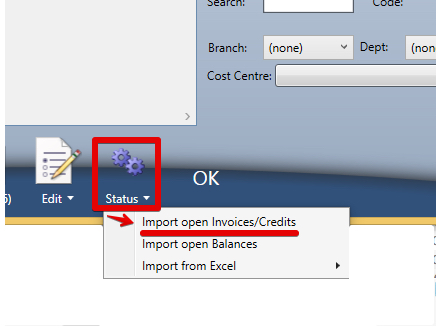Use Sidebar LHS to navigate
For global help click here
Importing Open Transactions
Import Open Invoices for Debtor and Creditor Journals
If you come from a previous system you are likely to have open invoices on suppliers and customers. To import
Make sure all financial periods are setup where invoices are to be created
Upload an XLS file to the General Journal Screen (drag onto the screen) with the following columns: (note can do this as separate spreadsheets if you like)
- Aged Payables = Creditor (creditor code), InvoiceDate, DueDate, Ref (invoice number), Amount, Journal (Type ie CI = creditor invoice, CCN = Creditor Credit Note), GLAccount
- Aged Receivables = Debtor (Debtor Code), InvoiceDate, DueDate, Ref (invoice number), Amount, Journal (Type ie DI = debtor invoice, DCN = Debtor Credit Note), GLAccount, OrderN
- to change imported invoices due dates on mass = SaaSref (Journal search code), Due date
Importing Trial Balances monthly for historical comparisons
See Upload or Import a General Journal from Excel#HistoricalTrialBalances
- Map the old system GL accounts to the new system GL accounts
- Ensure the previous year has the correct retained earnings figure. before the first year of operation you will need to put in a journal to create the desired retained earnings.
- Use the Trial Balance import wizard for each month - starting with the earliest month of interest. Note this is likely to be after the journal to create the opening Retained Earnings Figure.
Importing Sales Orders
Importing Financial Transaction History (ie Journals) = AVOID IF POSSIBLE
Transaction history is all sales orders, invoices credit notes etc from all time in the previous system.
This adds a lot of complexity to the set-up of a new company and will require the following decisions ;Think carefully what you need the information for - can it be done another way?
- Comparing financials with previous periods
- Instead enter a journal for historical transaction balances
- Your business has open invoices to be collected.
- Close as many invoices as possible before cutover to minimise this problem
- Enter a single invoice for each debtor instead of full history.
- * These will need to be dated the same day as the start of the company as if dated prior they will affect the accounting transactions
- * These will create accounting transactions and hence will affect the company opening journal to be entered.
- Enter single line invoices for a non-inventory product "Open Invoice Balance" to avoid inventory amounts being affected
- Bringing in historical accounting transactions will involve a lot of work. If possible look at starting the new business fresh for all new orders and wrap up the historical business over 3 months as you collect and pay outstandings through your previous system.
Importing Sales History
Sales history is not a financial transaction (ie a journal) and so is not a problem to import. Recommend imports are 40,000 records or less for each import to avoid timeouts.
If you want to have customer sales history to refer to or track warrantees on items you have historically supplied then Import sales history into a "Sales History" table
see
Related content
For information about SaaSplications go to http://saasplications.com.au
